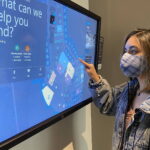 A profound dining transformation is happening at Microsoft as the company’s employees return to an office that’s evolved into a hybrid workplace.
A profound dining transformation is happening at Microsoft as the company’s employees return to an office that’s evolved into a hybrid workplace.
The pandemic has changed the way we work—and with it, the way we eat. Consumer expectations are evolving as people, including employees at Microsoft, get used to seamless, on-demand ordering through mobile applications and direct-to-you deliveries.
With Microsoft employees returning to the office after two years of working mostly remote, the Dining at Microsoft Operations team for the Puget Sound campus knew they needed to help them feel comfortable, fuel up, and be productive at work. They wanted to integrate new programs and ordering capabilities that would respect changing expectations and incorporate the intuitive nature of the mobile apps employees use at home.
Between Dining Operations and their partners on the Microsoft Digital team, plans were already in place to streamline the mobile ordering experience. The imminent return to work and the transition to a flexible, hybrid environment confirmed the urgency of the transformation. What began as an initiative to provide premium value for employees has become a necessary service consideration.
[See how Microsoft employees navigate their campuses with IoT tech and indoor mapping. Learn about the ways that Microsoft is modernizing the support experience with ServiceNow. Find out about reinventing the employee experience at Microsoft.]
A campus-scale challenge
With more than 70 dining locations on the Puget Sound campus and thousands of frequently changing menu items, Dining Operations’ challenge was to provide an experience that would feel intuitive for users and meet the needs of tens of thousands of diners each day. It would need to provide seamless food ordering and reflect the unfolding reality of hybrid work.
We recognize that from an employee experience standpoint, Dining at Microsoft needs to reflect our cultural principles, whether that’s around sustainability, accessibility, diversity and inclusion, or digital transformation. We have a job to do, and that’s to make sure we create a great dining experience for our employees every day and have our food and programming reflect who we are as an organization.
—Jodi Westwater, senior services manager of Dining Operations for the Puget Sound Campus
While online ordering was already available to employees through a browser-based point-of-sale (POS) platform, Dining Operations wanted a modern, intuitive, mobile-first experience to streamline how people browse menus and purchase items. They also wanted to integrate it into the digital environment employees use every day.
It was imperative that any solution should embody Microsoft’s priorities and culture.
“We recognize that from an employee experience standpoint, Dining at Microsoft needs to reflect our cultural principles, whether that’s around sustainability, accessibility, diversity and inclusion, or digital transformation,” says Jodi Westwater, senior services manager of Dining Operations for the Puget Sound Campus. “We have a job to do, and that’s to make sure we create a great dining experience for our employees every day and have our food and programming reflect who we are as an organization.”
Dining transformation, tailored to employees

The teams incorporated a mobile menu and ordering interface into an internal app that employee use to access transportation, explore their benefits, and manage other elements of their day-to-day roles. Incorporating dining into the app would mean that employees could order food in the mobile-friendly, full-service environment they already use.
To make the integration work, the team needed to bridge the gap between the internal mobile app and Dining Operations’ existing POS and menu tool. Since the POS system was originally intended as a standalone touch-screen service, the team used Microsoft Azure API to create the connective tissue between the platforms.
“One of the key focuses early on for building this integration was not only that the information be accurate for Microsoft end users,” says Thomas Po, a product manager on the Microsoft Digital team. “It also had to be relatively easy to use on the back end to minimize room for error and stay in sync with the operations side.”
POS integration was only part of the challenge. To meet Microsoft’s commitment to accessibility, the team worked closely with internal stakeholders to review and implement the Microsoft Accessibility Standards (MAS). They conducted user-group testing with employee resource groups, individuals, and Microsoft Digital’s internal accessibility experts. As a result, the app features inclusive elements like high-visibility contrast settings and read-along technology.
Since the app would be handling financial transactions in conjunction with third-party tools, it needed to be highly secure. So Microsoft Digital worked closely with the Finance Security team to ensure that the app met the strict data-capture and retention requirements built into all Microsoft technology.
Throughout the process, they leveraged tools throughout the Azure stack, including Azure API for integration with the dining POS system and Cosmos DB as a data repository, as well as other third-party tools hosted on Microsoft Azure.
The new ordering experience rolled out as a pilot in April of 2021 for use by essential employees working onsite, and it’s now in place across the entire Puget Sound Campus. The app allows employees to browse menus that feature images of the food at any dining location. They can order their food, pay digitally, and pick it up at the café, food hall, or espresso location of their choice.
From an experience standpoint, everything we do, design, and ideate must be user-centric, which for us means employee-led. What do employees need? What do we anticipate their habits to be? How will preferences change in a hybrid workplace? And how do we meet and exceed those ever-changing expectations?
—Jodi Westwater, senior services manager of Dining Operations for the Puget Sound Campus
The app automatically finds the nearest dining location based on an employee’s current whereabouts. In addition, iOS users can complete their transactions through Apple Pay, adding an extra layer of seamlessness to the mobile experience.
Employees can even browse the week’s menu ahead of time. With an increasing emphasis on hybrid workplaces and flexible in-person attendance, they might decide to make the trip to the office when their favorite food is available!
The mobile app integration doesn’t just reflect the intuitive experience of mobile food ordering that employees have embraced during the pandemic. It provides a way for workers who are understandably anxious about public eating spaces with the opportunity to retrieve their food quickly and eat on their own terms. It’s also a quick and easy solution for employees who have back-to-back meetings and may only have a few moments to grab food.
“From an experience standpoint, everything we do, design, and ideate must be customer-centric, which for us means employee-led,” Westwater says. “What do employees need? What do we anticipate their habits to be? How will preferences change in a hybrid workplace? And how do we meet and exceed those ever-changing expectations?”
The future of fueling up at work
Online ordering has more than tripled since before the pandemic. Previously, employees placed less than two percent of orders at the Puget Sound campus online. Now, approximately ten to twelve percent are placed digitally—at least a quarter of those via the mobile app. To make the feature even more accessible, the team will make dining order-ahead capabilities available on Microsoft Viva Connections, which will enable employees to order food on their mobile or desktop, using the same Microsoft Teams interface that they use throughout their day.
For diners who prefer the in-person experience or who might be anxious about crowding as more people return to work, Dining Operations is exploring a system that provides employees with more information about which cafés are busiest and when. The tool will use a mix of colors and graphics to indicate dining location traffic and occupancy so people can decide where they’d like to eat. This new functionality will also give staff valuable insights into usage patterns so they can use data to accommodate the ebb and flow of diners throughout the day and reduce food waste by ordering stock to reflect usage patterns accurately.
“Everything we’re doing is designed to create the most convenient and intuitive experience for Microsoft employees, visitors, and guests,” Westwater says. “We’re not just making sure we offer great food onsite, but that the ordering and dining process is accessible, that it makes sense, and that it’s easy to access.”

- Meet users where they’re at: There’s no such thing as one-size-fits-all.
- Build the app around the behavior: The app won’t change how users want to interact, so think about how they would use it.
- Put on your user hat: Consider everything from the customer perspective.
- Leverage user-testing: Identify your critical misses.
- Start small: Work with pilots and see what sticks.
- Nothing is sacred: Embrace reprioritization, pivot, and adapt.









